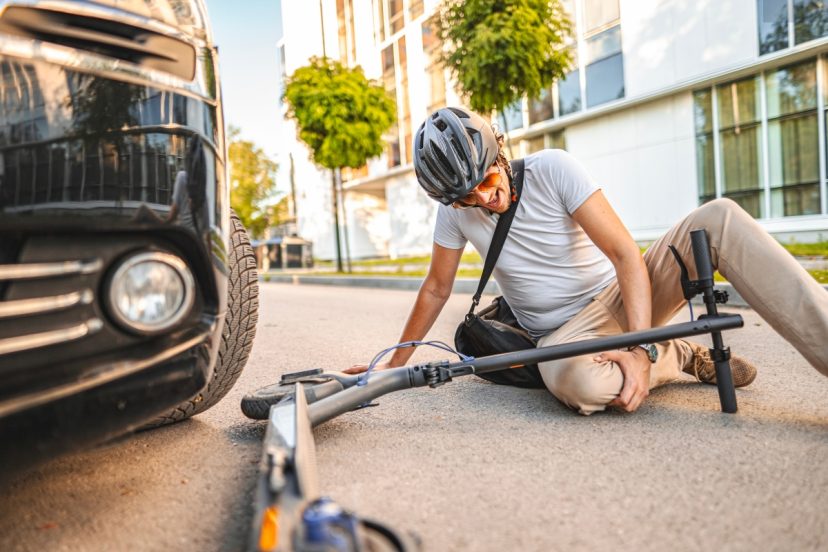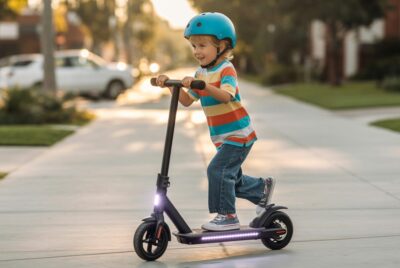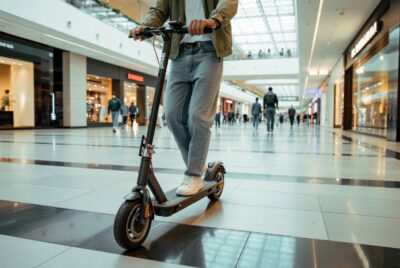E-Scooter Accident Prevention 2025
*We may earn a commission for purchases made using our links. Please see our disclosure to learn more.
The morning rush hour transforms city streets into a complex dance of vehicles, pedestrians, and increasingly, electric scooters. As micro-mobility continues to reshape urban transportation in 2025, the sight of commuters gliding silently on e-scooters has become as common as traditional bicycles. Yet beneath this convenient revolution lies a growing concern: the rising number of e-scooter accidents that can turn a simple commute into a life-changing event.
Picture this scenario: a rider confidently navigates through busy intersections, earbuds in, phone mounted for navigation, when suddenly a car door opens directly into their path. In that split second, the difference between a close call and a serious accident often comes down to preparation, awareness, and the right safety measures. This highlights the critical importance of e-scooter accident prevention—from obeying traffic rules and wearing protective gear to staying vigilant of potential hazards along the route.
“E-scooter injuries have increased by 222% from 2014 to 2018, with head injuries being the most common and severe type of trauma reported.”
– American Journal of Emergency Medicine
Key Takeaways
- Protective gear reduces injury severity by up to 85% when accidents occur
- Speed management and traffic awareness are critical for accident prevention
- Regular maintenance checks can prevent mechanical failures that lead to crashes
- Understanding local traffic laws helps riders navigate safely and legally
- Weather conditions significantly impact e-scooter safety and should guide riding decisions
Recommended Safety Products
1. CPSC Certified Multi-Sport Helmet
Stay safe while riding with the JBM Skateboard Helmet, designed for teens and adults. This helmet combines lightweight materials with tough impact-resistant PVC & EPS foam for optimal protection. With an aerodynamic design and multiple vents, it keeps you cool while you cruise. An adjustable strap ensures a snug, customizable fit, making it ideal for e-scooters, skateboarding, roller skating, and more. Available in multiple sizes and colors to suit your style.
- Impact Resistance: Tough PVC & EPS foam materials effectively absorb shock and protect your head.
- Ventilation: Multiple vents and breathable foam keep your head cool and reduce sweating.
- Adjustable Fit: Flexible strap design allows for a customized, comfortable fit for ages 14+.
- Limited Sizes: Only available in Medium (14+) and Large (16+), not suitable for younger kids.
- Basic Design: Lacks premium features like integrated lights or MIPS technology for enhanced safety.
- Color Availability: Some popular color options may be out of stock or limited.
A lightweight, adjustable helmet designed specifically for active riders and urban commuters. Built with a tough outer shell of PVC and impact-absorbing EPS foam, this helmet delivers exceptional protection while keeping weight to a minimum. The aerodynamic design features multiple ventilation channels and breathable foam padding to keep you cool and comfortable, even on long rides. The adjustable strap system ensures a secure, customized fit for teens and adults alike. Whether you’re commuting on an e-scooter, cruising on roller skates, or hitting the skatepark, this helmet plays a crucial role in e-scooter accident prevention, offering essential head protection and style in color options to suit every rider’s look.
2. High-Visibility Reflective Vest
Stay visible and organized on the job with the JKSafety Class 2 High Visibility Safety Vest. Made from 100% polyester H-Vis reflective material, this vest offers lightweight durability and breathability while meeting ANSI/ISEA 107 Class 2 standards for safety. Featuring 9 multi-functional front pockets with zipper and Velcro closures, it provides ample storage for essentials like your phone, flashlight, or laser pointer. The neon yellow color combined with 2-inch reflective strips around the waist, chest, shoulders, and back ensures 360° visibility in both daylight and low light conditions. Ideal for a wide range of applications including construction, surveying, security, and outdoor activities. Machine washable and designed for comfort, this vest is a reliable choice for safety professionals and outdoor enthusiasts alike.
- Visibility: High-visibility neon yellow with 360° reflective strips for enhanced safety in all lighting conditions
- Storage: Nine front pockets with secure closures provide ample, organized space for tools and personal items
- Comfort: Lightweight, breathable polyester material that’s machine washable and durable for daily use
- Sizing: Customers preferring a loose fit may need to order 1-2 sizes larger than usual
- Fit Variability: Some users may find the vest less adjustable due to fixed pocket placement
- Limited Color Options: While multiple colors exist, the most visible yellow may not suit all workplace dress codes
Breathable and comfortable safety vest designed for all-day wear, featuring 360-degree reflective strips that dramatically enhance visibility in low-light conditions such as dawn, dusk, and nighttime. The lightweight polyester fabric allows excellent airflow, keeping you cool and dry during long hours on the job or outdoor activities. Whether you’re cycling, jogging, working construction, or managing traffic, this vest ensures you stay visible from every angle, providing an essential layer of protection when it matters most. Its ergonomic design offers a snug yet flexible fit, allowing for full range of motion without sacrificing safety or comfort. Machine washable and durable, this vest combines functionality with lasting performance for all your high-visibility needs.
3. Protective Knee and Elbow Pads Set
Protect yourself with confidence during roller skating, skateboarding, cycling, or other action sports with the Tanden Adult Skating Protective Gear Set. Designed with an impact-resistant polypropylene (PP) shell and thick 9mm EVA padding, these knee, elbow, and wrist guards absorb shocks to reduce injury risks. The breathable elastic fabric on the back keeps you comfortable and ventilated, allowing unrestricted movement throughout your activity. Adjustable elastic straps ensure a secure and customizable fit for most adults, preventing slipping or shifting during falls. This versatile set includes all essential protective gear along with a convenient storage bag, making it perfect for sports enthusiasts who demand safety without compromising comfort or style.
- Protection: Impact-resistant PP shell and thick EVA padding provide superior shock absorption and injury prevention
- Comfort: Breathable, skin-friendly fabric with elastic backing offers airflow and flexibility during movement
- Adjustability: Multiple elastic straps allow for a customizable, secure fit that stays in place during activity
- Bulkiness: Some users may find the padding bulky for prolonged wear or certain movements
- Sizing Range: While adjustable, the fit may not be ideal for very small or larger adult knees and elbows
- Color Options: Limited standout color choices may not appeal to everyone looking for more vibrant gear
Durable and flexible padding engineered to deliver reliable impact protection while maintaining full freedom of movement. Designed with the daily commuter in mind, this gear offers a perfect balance of safety and comfort, allowing you to navigate busy streets and unpredictable environments with confidence. The lightweight materials adapt to your body’s natural motions, preventing any restriction or discomfort during extended wear. Whether you’re skating, biking, or scooting to work, this protective gear is essential for e-scooter accident prevention, ensuring you stay safeguarded against falls and bumps without sacrificing agility or style.
4. Smart Bike Light Set with Turn Signals
Enhance your night rides with the WSDCAM Bike Light Set, combining powerful illumination, advanced safety features, and theft protection in one compact kit. The ultra-bright front headlight offers 900 lumens across six versatile modes—including low, high, flash, and daytime running light—ensuring clear visibility on dark roads and trails. The rear tail light features 31 LEDs with six modes for maximum visibility, plus integrated smart functions such as turn signals controlled by an easy-to-use handlebar remote, automatic brake light activation, and a 110-decibel electric horn to alert pedestrians and vehicles. The included anti-theft vibration alarm adds peace of mind with adjustable sensitivity settings to protect your bike when parked. Both front and rear lights are rechargeable and water-resistant (IP65), making this set perfect for all weather conditions and daily commuting or recreational cycling.
- Visibility: Ultra-bright 900-lumen front light and wide-angle rear light with multiple modes increase safety on roads at any time of day
- Smart Features: Integrated turn signals, brake light sensor, and remote-controlled horn improve communication with drivers and pedestrians
- Security: Anti-theft vibration alarm with adjustable sensitivity provides added protection against bike theft
- Complex Setup: Some users may find initial installation and syncing of remote controls and lights slightly complicated
- Battery Life: Frequent use of multiple light modes and horn may reduce battery runtime between charges
- Remote Range: Remote control requires close proximity to the bike handlebar to function effectively
Wireless LED lighting system featuring bright brake lights and turn indicators that seamlessly sync with easy-to-use handlebar controls. This advanced setup significantly improves communication with other road users by clearly signaling your movements in real-time. Designed for effortless operation, the wireless connection eliminates clutter from wires, allowing for a clean and streamlined bike setup. Whether you’re navigating busy city streets or dimly lit paths, the responsive brake lights and flashing turn signals increase your visibility and safety, helping drivers and pedestrians anticipate your next move. Ideal for cyclists who prioritize both convenience and enhanced road awareness during day and night rides.
The Silent Revolution and Its Hidden Dangers
Electric scooters have revolutionized urban mobility, offering a convenient bridge between walking and driving. However, this convenience comes with unique risks that many riders underestimate. Unlike traditional bicycles, e-scooters accelerate quickly and silently, catching both riders and other road users off guard.
The statistics paint a concerning picture: emergency departments across major cities report a steady increase in e-scooter-related injuries, with head trauma, fractures, and soft tissue injuries being the most common. What makes these accidents particularly troubling is that many are entirely preventable with proper safety measures and awareness. That’s why e-scooter accident prevention is more important than ever, ensuring riders and pedestrians alike can enjoy the benefits of micro-mobility without unnecessary risks.
Understanding the Risk Landscape
Traffic Integration Challenges
E-scooter riders often find themselves in a gray area of traffic laws. Too fast for sidewalks but seemingly vulnerable on roads, riders must navigate complex urban environments where their rights and responsibilities aren’t always clear. This uncertainty creates dangerous situations where riders make split-second decisions without proper guidance.
The integration challenge extends beyond legal ambiguity. Drivers aren’t always accustomed to sharing road space with e-scooters, leading to misjudged distances and unexpected interactions. Similarly, pedestrians may not anticipate the speed and silence of approaching e-scooters, particularly in shared spaces.
Mechanical Vulnerabilities
Unlike personal vehicles that undergo regular maintenance, shared e-scooters often suffer from wear and tear that goes unnoticed until failure occurs. Brake degradation, tire wear, and loose handlebars are common issues that can transform a routine ride into an emergency situation.
Personal e-scooter owners face different challenges: the responsibility of maintenance falls entirely on them, yet many lack the knowledge to identify potential problems before they become dangerous.
Essential Safety Strategies for 2025
Pre-Ride Safety Protocols
Every safe journey begins before the wheels start turning. Developing a consistent pre-ride routine can prevent mechanical failures and ensure optimal riding conditions. This routine should include checking tire pressure, testing brakes, ensuring all bolts are secure, and verifying that lights and signals function properly.
Weather assessment plays a crucial role in ride planning. Wet surfaces dramatically reduce tire traction, while strong winds can affect stability and control. Temperature extremes can impact battery performance, potentially leaving riders stranded or with reduced power when needed most.
Protective Equipment Mastery
The right protective gear serves as the crucial barrier between a minor tumble and a serious injury. While helmets receive the most attention, comprehensive protection involves multiple components working together.
Modern helmet technology has evolved significantly, with designs specifically optimized for e-scooter use. These helmets balance protection with comfort, featuring enhanced ventilation and integrated lighting systems that improve visibility without adding bulk.
Beyond head protection, joint protection becomes essential for frequent riders. Knee and elbow pads designed for urban mobility offer protection without the bulk associated with traditional sports padding. These streamlined designs integrate seamlessly into everyday clothing while providing crucial impact absorption.
Successful e-scooter riding requires developing an enhanced awareness of traffic patterns and potential hazards. This involves understanding the unique positioning challenges e-scooters face in traffic flow and learning to communicate effectively with other road users.
Positioning within traffic lanes requires careful consideration of visibility and escape routes. Riding too close to parked cars increases the risk of “dooring” accidents, while riding too far into traffic lanes can lead to conflicts with faster vehicles.
Signal communication becomes particularly important for e-scooter riders who lack the traditional indicators found on motor vehicles. Learning to use hand signals effectively and positioning oneself predictably helps other road users anticipate movements and react appropriately.
Advanced Accident Prevention Techniques
Defensive Riding Strategies
Defensive riding extends beyond simple rule-following to develop an anticipatory mindset that identifies potential hazards before they become immediate threats. This involves scanning ahead for obstacles, maintaining awareness of surrounding traffic, and always having an escape plan.
The concept of “space cushioning” becomes particularly important for e-scooter riders. Unlike cars with protective shells, e-scooter riders are fully exposed to impact. Maintaining adequate space in all directions provides time and room to react to sudden changes in traffic conditions.
Intersection navigation requires special attention, as these locations account for a significant percentage of e-scooter accidents. Understanding traffic light timing, checking for turning vehicles, and making eye contact with drivers can prevent many common collision scenarios.
Technology Integration
Modern e-scooters increasingly incorporate safety technology that can significantly reduce accident risk when properly utilized. Features like regenerative braking, cruise control, and app-based route planning can enhance safety when riders understand their proper application.
GPS tracking and emergency notification systems provide additional safety layers, particularly for solo riders in unfamiliar areas. These systems can automatically alert emergency contacts or services in the event of an accident, potentially reducing response times when injuries occur.
Environmental Awareness and Adaptation
Weather-Specific Strategies
Different weather conditions require distinct approaches to e-scooter safety. Rain creates obvious traction challenges, but riders often underestimate the impact of temperature changes on battery performance and tire pressure.
Cold weather riding presents unique challenges as batteries drain faster and tire pressure drops, affecting handling characteristics. Proper preparation includes battery management strategies and pressure adjustments that maintain optimal performance.
Hot weather creates different concerns, including potential battery overheating and increased rider fatigue. Understanding these limitations helps riders make informed decisions about route planning and timing.
City riding involves constantly changing conditions that require adaptive strategies. Construction zones, special events, and rush hour traffic patterns all create unique challenges that riders must navigate safely.
Learning to identify and avoid high-risk areas during peak danger times can significantly reduce accident exposure. This might involve route modifications during school dismissal times or avoiding certain intersections during rush hour periods.
Building a Safety-First Community
Education and Awareness
Creating a culture of safety requires ongoing education that extends beyond individual riders to include all road users. Understanding how to share space safely benefits everyone and reduces conflict situations that can lead to accidents.
Community education programs that include drivers, pedestrians, and riders create shared understanding of rights, responsibilities, and safe interaction practices. These programs prove particularly effective when they address local traffic patterns and specific hazard locations.
Maintenance and Longevity
Regular maintenance extends beyond safety to impact the overall e-scooter experience. Well-maintained scooters provide more predictable handling and reliable performance, reducing the likelihood of mechanical failures that can cause accidents.
Developing maintenance knowledge empowers riders to identify potential problems early and address them before they become safety hazards. This includes understanding normal wear patterns and recognizing when professional service becomes necessary.
The Path Forward: Creating Safer Streets
E-scooter accident prevention in 2025 requires a comprehensive approach that addresses individual behavior, technology integration, and community awareness. The goal isn’t to eliminate all risk—that’s impossible with any form of transportation—but to minimize preventable accidents through preparation, awareness, and responsible riding practices.
The future of urban mobility depends on successfully integrating e-scooters into existing transportation systems while maintaining safety for all road users. This integration requires ongoing adaptation as technology evolves and cities develop infrastructure that better accommodates micro-mobility options.
Success in this endeavor requires commitment from riders to prioritize safety, from cities to develop appropriate infrastructure and regulations, and from the broader community to embrace shared responsibility for road safety. Together, these efforts can help realize the promise of e-scooters as a safe, efficient, and sustainable transportation option.
Conclusion
E-scooter accident prevention in 2025 isn’t just about following rules or wearing gear—it’s about developing a comprehensive safety mindset that encompasses preparation, awareness, and continuous learning. The statistics may be sobering, but they also highlight the significant impact that proper safety measures can have on reducing injury risk.
The key to safer e-scooter riding lies in treating safety as an ongoing practice rather than a one-time consideration. Regular equipment checks, continuous skill development, and staying informed about best practices create a foundation for e-scooter accident prevention that adapts to changing conditions and circumstances.
As e-scooters continue to evolve and integrate into urban transportation systems, riders who prioritize safety today are building habits that will serve them well as technology and infrastructure continue to develop. The investment in safety knowledge and equipment pays dividends not just in injury prevention, but in confidence and enjoyment of this convenient transportation option.
Remember that every ride is an opportunity to practice safe habits and contribute to a positive perception of e-scooter users in the broader community. By prioritizing e-scooter accident prevention and responsibility, riders help ensure that e-scooters remain a viable and welcome part of urban mobility solutions.
Frequently Asked Questions
Q: What is the most important piece of safety equipment for e-scooter riders?
A: While all protective gear is important, a properly fitted helmet certified for bicycle/scooter use provides the most critical protection. Head injuries are the most severe type of e-scooter accident injury, and helmets can reduce the risk of serious head trauma by up to 85%.
Q: Are there specific traffic laws for e-scooters that differ from bicycle laws?
A: E-scooter laws vary significantly by location and are rapidly evolving. Many jurisdictions treat e-scooters similarly to bicycles, but speed limits, where they can be ridden (road vs. bike lane vs. sidewalk), and age restrictions often differ. Always check local regulations before riding in a new area.
A: Before riding any shared e-scooter, check the brakes by squeezing the levers, ensure the handlebars are secure and properly aligned, verify the tires have adequate tread and proper inflation, and test that the throttle and display function correctly. Report any issues through the app before riding.
Q: What should I do immediately after an e-scooter accident?
A: First, move to safety if possible and assess for injuries. Call emergency services if anyone is hurt. Document the scene with photos, exchange information with any other parties involved, and report the incident to your insurance company and the e-scooter company if using a shared scooter. Seek medical attention even for seemingly minor injuries, as some symptoms may appear later.
Q: How fast is too fast when riding an e-scooter?
A: Speed should always match conditions rather than the scooter’s maximum capability. In crowded areas, 5-8 mph is often appropriate, while open bike lanes might allow for higher speeds up to local limits (typically 15-20 mph). Key factors include traffic density, surface conditions, weather, and your experience level. Remember that reaction time decreases significantly as speed increases.
















